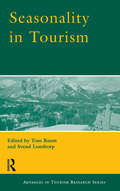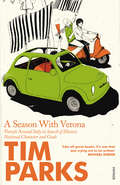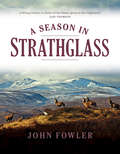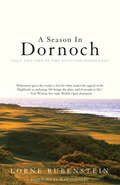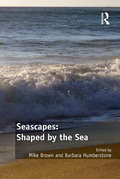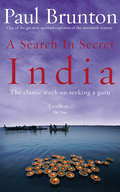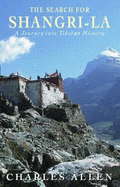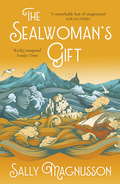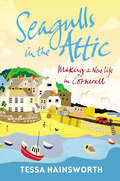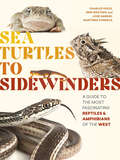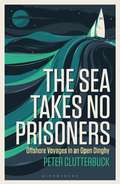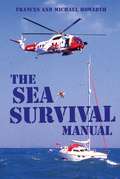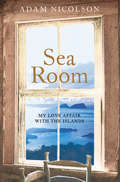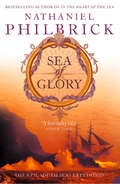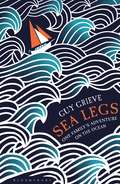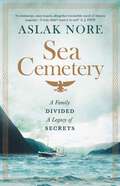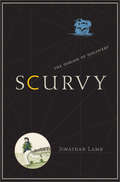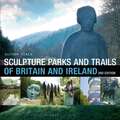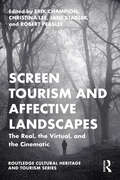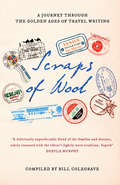- Table View
- List View
Seasonality in Tourism
by Tom Baum Svend LundtorpSeasonal variation in demand is a reality for most tourism destinations. This work provides a balanced overview of the evidence and issues relating to tourism seasonality using European, North American and Pacific Rim cases and research evidence.
Seasonality in Tourism (Advances In Tourism Research Ser.)
by Tom Baum Svend LundtropSeasonal variation in demand is a reality for most tourism destinations. This work provides a balanced overview of the evidence and issues relating to tourism seasonality using European, North American and Pacific Rim cases and research evidence.
A Season With Verona: Travels Around Italy In Search Of Illusion, National Character, And... Goals!
by Tim ParksIs Italy a united country, or a loose affiliation of warring states? Is Italian football a sport, or an ill-disguised protraction of ancient enmities?Tim Parks goes on the road to follow the fortunes of Hellas Verona football club, to pay a different kind of visit to some of the world's most beautiful cities. This is a highly personal account of one man's relationship with a country, its people and its national sport. A book that combines the pleasures of travel writing with a profound analysis of one country's mad, mad way of keeping itself entertained.
A Season in Strathglass
by John FowlerThe three Scottish Highland glens of Affric, Cannich and Strathfarrar which make up Strathglass are places of craggy hills, ancient pinewoods and many waters. John Fowler has made frequent journeys there during which he has spent time with deerstalkers, joined naturalists on moorland surveys and wandered among the ancient pines of the Caledonian forest. He also met a cast of remarkable characters: Sister Petra Clare, a nun who creates lustrous religious icons; Stuart, whose home is like a hobbit's, a cabin of delights which he constructed in the woods to fit his modest stature; George, man of many trades, living encyclopedia of all things local and eloquent raconteur; Old Duncan , prince of stalkers, a hale ninety-something whose vivid reminiscences of life in the glen make fascinating reading; Iain Thomson, guardsman, shepherd, cattleman, deep-sea sailor, farmer now turned author; and a host of others. In this book John Fowler offers a fascinating, poignant and affectionate portrait of this remarkable land and its people.
A Season in Dornoch: Golf and Life in the Scottish Highlands (Mainstream Sport Ser. (PDF))
by Lorne RubensteinIn 1977, Lorne Rubenstein, an avid golfer, travelled to Dornoch in the Scottish Highlands. Young and adrift in life, he was profoundly affected by the experience. As he writes, 'My week in Dornoch introduced me to a place with which I felt a connection. A week wasn't living there, but it was enough for Dornoch to imprint itself on my mind.' Twenty-three years later, in 2000, now an established golf writer, Rubenstein returned to Dornoch to spend an entire summer. He rented a flat close to the Royal Dornoch Golf Club and set out to explore the area on many levels. Rubenstein writes about the melancholy history of the Highland Clearances, which have left the beautiful landscape sparsely populated to this day. He writes about the friendly and sometimes eccentric people who love their town, their golf and their single malt whisky, and who delight in sharing them with visitors. But most of all he writes about a summer lived in a community where golf is king and the golf course is part of the common lands where townspeople stroll of an evening. Rubenstein is able to return to thinking of golf as play, as opposed to a game of analysis and effort. A Season in Dornoch is an affectionate portrait of a place and the people who live there, a fascinating look at golf and the spirit and skills it calls forth, and a perceptive and ultimately moving memoir of one man's quest to experience again the pure love of sport that he knew in his youth.
Seascapes: Shaped by the Sea
by Mike Brown Barbara HumberstoneDespite the fact that the sea covers 70 per cent of the Earth’s surface, and is integral to the workings of the world, it has been largely neglected or perceived as marginal in modern consciousness. This edited collection disrupts notions of the sea as ’other’, as foreign and featureless, through specific, situated accounts which highlight the centrality of the sea for the individuals concerned. Bringing together academics who combine scholarly expertise with lived experiences on, in and with the sea, it examines humans’ relationships with the sea. Through the use of auto-ethnographic accounting, the contributors reflect on how the sea has shaped their sense of identity, belonging and connection. They examine what it is to be engaged with the sea, and narrate their lived, sentient, corporeal experiences. The sea is a cultural seascape just as it is physical reality. The sea shapes us and we, in turn, attempt to ’shape it’ as we construct various versions of it that reflect our on-going and mutable relationship with it. The use of embodied accounts, as a way of conveying lived-experiences, and the integration of relevant theoretical frames for understanding the broader cultural implications provide new opportunities to understand seascapes.
Seascapes: Shaped By The Sea
by Mike Brown Barbara HumberstoneDespite the fact that the sea covers 70 per cent of the Earth’s surface, and is integral to the workings of the world, it has been largely neglected or perceived as marginal in modern consciousness. This edited collection disrupts notions of the sea as ’other’, as foreign and featureless, through specific, situated accounts which highlight the centrality of the sea for the individuals concerned. Bringing together academics who combine scholarly expertise with lived experiences on, in and with the sea, it examines humans’ relationships with the sea. Through the use of auto-ethnographic accounting, the contributors reflect on how the sea has shaped their sense of identity, belonging and connection. They examine what it is to be engaged with the sea, and narrate their lived, sentient, corporeal experiences. The sea is a cultural seascape just as it is physical reality. The sea shapes us and we, in turn, attempt to ’shape it’ as we construct various versions of it that reflect our on-going and mutable relationship with it. The use of embodied accounts, as a way of conveying lived-experiences, and the integration of relevant theoretical frames for understanding the broader cultural implications provide new opportunities to understand seascapes.
A Search In Secret India: The classic work on seeking a guru
by Paul Brunton'He found many marvelous things...But now and then a man of real spirituality set his feet on the way that finally led him to what he had looked and hoped for.' New York Times Book Review The late Paul Brunton was one of the twentieth century's greatest explorers of and writers on the spiritual traditions of the East. A Search in Secret India is the story of Paul Brunton's journey around India, living among yogis, mystics and gurus, some of whom he found convincing, others not. He finally finds the peace and tranquility which come with self-knowledge when he meets and studies with the great sage Sri Ramana Maharishi.
The Search For Shangri-La: A Journey into Tibetan History
by Charles AllenThe idea of a hidden refuge, a paradise far from the stresses of modern life, has universal appeal. In 1932 the writer James Hilton coined the word 'Shangri-La' to describe such a place, when he gave that name to a hidden valley in the Himalayas in his novel LOST HORIZON.In THE SEARCH FOR SHANGRI-LA acclaimed traveller and writer Charles Allen explores the myth behind the story. He tracks down the sources that Hilton drew upon in writing his popular romance, and then sets out to discover what lies behind the legend that inspired him. In the course of a lively and amusing account of his four journeys into Tibet, Allen also gives us a controversial new reading of the country's early history, shattering our notions of Tibet as a Buddhist paradise and restoring the mysterious pre-Buddhist religion of Bon to its rightful place in Tibetan culture. He also locates the lost kingdom of Shang-shung and, in doing so, the original Shangri-La itself: in an astounding gorge beyond the Himalayas, full of extraordinary ruins.
The Sealwoman's Gift: the Zoe Ball book club novel of 17th century Iceland
by Sally Magnusson'A remarkable feat of imagination ... I enjoyed and admired it in equal measure' Sarah Perry, author of The Essex Serpent1627. In a notorious historical event, pirates raided the coast of Iceland and abducted 400 people into slavery in Algiers. Among them a pastor, his wife, and their children.In her acclaimed debut novel Sally Magnusson imagines what history does not record: the experience of Asta, the pastor's wife, as she faces her losses with the one thing left to her - the stories from home - and forges an ambiguous bond with the man who bought her. Uplifting, moving, and sharply witty, The Sealwoman's Gift speaks across centuries and oceans about loss, love, resilience and redemption.SHORTLISTED FOR THE HWA DEBUT CROWN | THE BEST FIRST NOVEL AWARD | THE MCKITTERICK PRIZE | THE PAUL TORDAY MEMORIAL PRIZE | THE WAVERTON GOOD READ AWARD | A ZOE BALL ITV BOOK CLUB PICK'Sally Magnusson has taken an amazing true event and created a brilliant first novel. It's an epic journey in every sense: although it's historical, it's incredibly relevant to our world today. We had to pick it' Zoe Ball Book Club'A powerful tale of Barbary pirates ... richly imagined and energetically told' Sunday Times 'An extraordinarily immersive read ... examining themes of motherhood, identity, exile and freedom' Guardian'Fascinating ... a really, really good read' BBC R2 Book Club'The best sort of historical novel' Scotsman 'A lyrical tale' Stylist 'A poetic retelling of Icelandic history' Daily Mail 'Compelling stuff' Good Housekeeping'Icelandic history has been brought to extraordinary life... An accomplished and intelligent novel' Yrsa Sigurðardóttir, author of Why Did You Lie?'Vivid and compelling' Adam Nichols, co-translator of The Travels of Reverend Ólafur Egilsson
Seagulls in the Attic: Making A New Life In Cornwall
by Tessa HainsworthHaving given up a high-powered job and the lifestyle to match, Tessa Hainsworth had no idea how hard she would struggle when, full of optimism, she fulfilled her dream of moving to rural Cornwall with her young family one September. In the first book Up With the Larks Tessa charted her first turbulent year with the Royal Mail, and her transformation from outsider to 'Posh Postie', adopted Cornishwoman and much-loved member of her new community.In Seagulls in the Attic Tessa is now a pillar of the community, or so she thinks. Life is becoming hard for her and her family as they realise that being part of a small community is not quite the idyll she had been lead to believe, as lack of money and the demands of family life take their toll. But, as with the first book, Tessa finds the fun and resilience to turn all the hardships to her advantage - eventually.The first book sold over 6,000 copies in hardcover and is rapidly becoming a must-read book for all those who hanker for an escape to the country.
Sea Turtles to Sidewinders: A Guide to the Most Fascinating Reptiles and Amphibians of the West
by Charles Hood Erin Westeen Jose Gabriel Martinez-Fonseca"For families wanting to explore their local wildlife as well as an engaging read for those with a general interest in the subject.&” —Booklist The American West is home to a wide array of reptiles and amphibians-from the rare and curious to those that can be found in parks and backyards. With this user-friendly guide in hand, discover the most likely-to-be-encountered lizards, snakes, turtles, and amphibians native to Arizona, California, Idaho, Nevada, Oregon, Utah, and Washington, plus the western parts of Montana, Wyoming, Colorado, and New Mexico. Whether you are a dedicated herper or simply have a keen interest in wildlife and natural history, Sea Turtles to Sidewinders—from Charles Hood, Erin Westeen, and Jose Gabriel Martfnez-Fonsec—will help you appreciate and celebrate the amazing diversity represented by reptiles and amphibians of the West.
The Sea Takes No Prisoners: Offshore voyages in an open dinghy
by Peter ClutterbuckThis is a classic real-life story of derring do on the high seas, complete with extreme risk, last-minute ingenuity and many near-misses. Beginning in the 1960s, this book tells of the real life adventures of the author as a boy – a time of boarding schools, long holidays and an unbelievable (to today's parents) amount of freedom and danger. Encouraged by his parents (who lived abroad) to become more independent and self-sufficient, Peter decided to see how far he could get in his family's small open dinghy Calypso. Aged 16, he spent a winter restoring her, before pootling straight out into a force 7 gale and very nearly capsizing, after which he headed back to land to plan even more extreme adventures. Calypso was a Wayfarer, a small (16ft) and very popular class of open dinghy; a boat designed for pottering around coastlines and estuaries during the day. But along with the occasional brave crewmate, Peter managed to sail her across the Channel, through the Bay of Biscay, down the French canals and into the Mediterranean, then up into the North Sea and the Baltic to Oslo, living aboard for three months at a time. These were some of the longest voyages that anyone had ever achieved in an open boat, where (as Peter says) you 'have to be like a tightrope walker, concentrating on balance day and night, fully aware of the consequence of relaxing your vigilance'. He survived huge waves, nine rudder breakages in heavy seas, dismasting, capsizes, and hallucinations caused by sleep deprivation. He also managed it on a tiny budget, working as a farm labourer, hitchhiking everywhere, and at times living on one meal of cereal a day, to save the maximum amount for his boat. Charming, quite British in style, beautifully written and a lovely insight into a seemingly golden time, this is primarily a great read, but will be of huge practical use to anyone wanting to go that bit further in their dinghy. It also includes a lovely Foreword by world-famous yachtsman Brian Thompson.
The Sea Takes No Prisoners: Offshore voyages in an open dinghy
by Peter ClutterbuckThis is a classic real-life story of derring do on the high seas, complete with extreme risk, last-minute ingenuity and many near-misses. Beginning in the 1960s, this book tells of the real life adventures of the author as a boy – a time of boarding schools, long holidays and an unbelievable (to today's parents) amount of freedom and danger. Encouraged by his parents (who lived abroad) to become more independent and self-sufficient, Peter decided to see how far he could get in his family's small open dinghy Calypso. Aged 16, he spent a winter restoring her, before pootling straight out into a force 7 gale and very nearly capsizing, after which he headed back to land to plan even more extreme adventures. Calypso was a Wayfarer, a small (16ft) and very popular class of open dinghy; a boat designed for pottering around coastlines and estuaries during the day. But along with the occasional brave crewmate, Peter managed to sail her across the Channel, through the Bay of Biscay, down the French canals and into the Mediterranean, then up into the North Sea and the Baltic to Oslo, living aboard for three months at a time. These were some of the longest voyages that anyone had ever achieved in an open boat, where (as Peter says) you 'have to be like a tightrope walker, concentrating on balance day and night, fully aware of the consequence of relaxing your vigilance'. He survived huge waves, nine rudder breakages in heavy seas, dismasting, capsizes, and hallucinations caused by sleep deprivation. He also managed it on a tiny budget, working as a farm labourer, hitchhiking everywhere, and at times living on one meal of cereal a day, to save the maximum amount for his boat. Charming, quite British in style, beautifully written and a lovely insight into a seemingly golden time, this is primarily a great read, but will be of huge practical use to anyone wanting to go that bit further in their dinghy. It also includes a lovely Foreword by world-famous yachtsman Brian Thompson.
The Sea Survival Manual
by Frances Howorth Michael HoworthThe Sea Survival Manual is the definitive book on the subject for anyone aboard a yacht of any size. It is aimed at the yachtsman or seafarer who is likely to proceed to sea out of the sight of land, whether for pleasure or professional reasons. Fully compliant with the IMO (International Maritime Organisation) resolutions and MCA (Maritime Coastguard Agency) regulations it embodies Sea Safety checks issued by the MCA and RNLI and is completely international in its appeal. Includes chapters on safety and survival equipment, Global Maritime Distress and Safety Systems (GMDSS), liferafts, grab bags, medical equipment and advice, first aid and emergency treatment, abandoning ship, survival in a liferaft and rescues at sea. This is the first modern book to tackle the subject from the small craft point of view.
Sea Room: An Island Life In The Hebrides
by Adam NicolsonHave you ever wondered what it would be like to be given your own remote islands? Thirty years ago it happened to Adam Nicolson.
Sea of Glory: The Epic South Seas Expedition 1838-42
by Nathaniel PhilbrickThis ebook contains a limited number of illustrations. Due to the level of detail, maps are best viewed on a tablet. The dramatic story of the largest voyage of discovery in the history of the world, this is an astounding tale of courage, arrogance and adventure on the high seas from the author of ‘In the Heart of the Sea’.
Sea Legs: One Family's Year on the Ocean
by Guy GrieveThree years after his return from the Alaskan wilderness, Guy Grieve was living on the Isle of Mull in Scotland with his wife Juliet and their two young sons. Sick of the weather, perennial colds and their increasingly routine lifestyle, they'd all been getting restless. Finally, Guy and Juliet broke in spectacular style – they re-mortgaged their house and bought a yacht. Her name was Forever.The plan? To pick up Forever from her mooring in the Leeward Antilles off the coast of Venezuela, and sail around the West Indies before crossing the Atlantic back to Scotland. This was despite the fact that Guy, skipper of the expedition, had almost no sailing experience. Travelling around the lush tropical islands of the Caribbean and up the waterways of America, the family had countless sublime moments as they discovered the freedoms of sailing – anchoring in deserted bays, night passages under star-studded skies, and entering New York by water, greeted by the Statue of Liberty. But there were also testing times as they grappled with seasickness and bad weather, coping with young children at sea and learning to run a large, complex boat. Far from being the idyllic escape they'd envisaged, the journey forced Guy and Juliet to draw on reserves of courage and endurance they never knew they had. Wry, funny and buccaneering, this is a compelling tale of bravery and endeavour, out on the open sea.
The Sea Cemetery: Secrets and lies in a bestselling Norwegian family drama (The Falck Saga #1)
by Aslak Nore"A windswept, wave-tossed, altogether irresistible novel of literary suspense - I truly didn't want it to end" A. J. FINN"In its scale, scope and ambition, The Sea Cemetery is truly epic" COLIN WALSH"This saga will delight fans of 'Succession'" Elle"The strength of its storytelling and its romantic energy make it a perfect example of an authentic page turner" Livres HebdoThere is no love lost between the Oslo and Bergen branches of the powerful Falck family. So when its steely matriarch dies with no will to be found, the seeds of an inheritance dispute are sown.Yet her legacy could be more damaging still. A manuscript confiscated by the secret police in the seventies holds devastating secrets about the Falcks' activities during the war. Her granddaughter Sasha is set on uncovering the truth, whatever the cost, bringing her into conflict with her father, whose family loyalty is matched only by his patriotic fervour. And in the wings waits Hans Falck, war doctor and philanderer, head of the impoverished Bergen branch, who has a few secrets of his own.It all leads back to the sinking of the SS Prinsesse Ragnhild, lost to a British mine in 1940. But can the official verdict be trusted? The shocking truth lies 300 metres under the sea.Part literary thriller, part sweeping family saga, The Sea Cemetery is a dark and dramatic tale of secrets, betrayals and doomed love, drawing on the true story of one of Norway's most devastating maritime disasters.Translated from the Norwegian by Deborah Dawkin
Scurvy: The Disease of Discovery
by Jonathan LambScurvy, a disease often associated with long stretches of maritime travel, generated sensations exceeding the standard of what was normal. Eyes dazzled, skin was morbidly sensitive, emotions veered between disgust and delight. In this book, Jonathan Lamb presents an intellectual history of scurvy unlike any other, probing the speechless encounter with powerful sensations to tell the story of the disease that its victims couldn't because they found their illness too terrible and, in some cases, too exciting.Drawing on historical accounts from scientists and voyagers as well as major literary works, Lamb traces the cultural impact of scurvy during the eighteenth-century age of geographical and scientific discovery. He explains the medical knowledge surrounding scurvy and the debates about its cause, prevention, and attempted cures. He vividly describes the phenomenon and experience of "scorbutic nostalgia," in which victims imagined mirages of food, water, or home, and then wept when such pleasures proved impossible to consume or reach. Lamb argues that a culture of scurvy arose in the colony of Australia, which was prey to the disease in its early years, and identifies a literature of scurvy in the works of such figures as Herman Melville, Samuel Taylor Coleridge, Francis Bacon, and Jonathan Swift.Masterful and illuminating, Scurvy shows how the journeys of discovery in the eighteenth century not only ventured outward to the ends of the earth, but were also an inward voyage into the realms of sensation and passion.
Scurvy: The Disease of Discovery
by Jonathan LambScurvy, a disease often associated with long stretches of maritime travel, generated sensations exceeding the standard of what was normal. Eyes dazzled, skin was morbidly sensitive, emotions veered between disgust and delight. In this book, Jonathan Lamb presents an intellectual history of scurvy unlike any other, probing the speechless encounter with powerful sensations to tell the story of the disease that its victims couldn't because they found their illness too terrible and, in some cases, too exciting.Drawing on historical accounts from scientists and voyagers as well as major literary works, Lamb traces the cultural impact of scurvy during the eighteenth-century age of geographical and scientific discovery. He explains the medical knowledge surrounding scurvy and the debates about its cause, prevention, and attempted cures. He vividly describes the phenomenon and experience of "scorbutic nostalgia," in which victims imagined mirages of food, water, or home, and then wept when such pleasures proved impossible to consume or reach. Lamb argues that a culture of scurvy arose in the colony of Australia, which was prey to the disease in its early years, and identifies a literature of scurvy in the works of such figures as Herman Melville, Samuel Taylor Coleridge, Francis Bacon, and Jonathan Swift.Masterful and illuminating, Scurvy shows how the journeys of discovery in the eighteenth century not only ventured outward to the ends of the earth, but were also an inward voyage into the realms of sensation and passion.
Sculpture Parks and Trails of Britain & Ireland
by Alison StaceThe ultimate illustrated guide to the sculpture parks and trails of England, Scotland, Ireland and Wales.This exciting guide to the sculpture parks, trails and gardens of England, Ireland, Scotland and Wales is the perfect book for those who like art and the outdoors. Divided up into countries and regions, the book is informative as well as beautifully illustrated with fabulous images of sculptures by a broad array of international artists. It provides information on all the major sculpture venues of interest, featuring the best and most established, while also providing a wide range of other interesting places to visit and explore. Each feature provides directions of how to get there, along with an overview of the park or trail, and lists sculptures of particular interest and quality, while maps of each area will help you find places close by to visit. This makes it easy to see which places are suited to you depending on your preferences, level of interest and time available. This fully revised 2nd edition provides updated information and new entries for England, as well as brand new sections providing thorough coverage of Scotland, Ireland and Wales. The ideal guide for those with a passion for both nature and sculptures.
Screen Tourism and Affective Landscapes: The Real, the Virtual, and the Cinematic (Routledge Cultural Heritage and Tourism Series)
by Erik Champion Christina Lee Jane Stadler Robert Moses PeasleeThis book explores ways in which screen-based storyworlds transfix, transform, and transport us imaginatively, physically, and virtually to the places they depict or film. Topics include fantasy quests in computer games, celebrity walking tours, dark tourism sites, Hobbiton as theme park, surf movies, and social gangs of Disneyland. How physical, virtual, and imagined locations create a sense of place through their immediate experience or visitation is undergoing a revolution in technology, travel modes, and tourism behaviour. This edited collection explores the rapidly evolving field of screen tourism and the affective impact of landscape, with provocative questions and investigations of social groups, fan culture, new technology, and the wider changing trends in screen tourism. We provide critical examples of affective landscapes across a wide range of mediums (from the big screen to the small screen) and locations. This book will appeal to students and scholars in film and tourism, as well as geography, design, media and communication studies, game studies, and digital humanities.
Screen Tourism and Affective Landscapes: The Real, the Virtual, and the Cinematic (Routledge Cultural Heritage and Tourism Series)
by Erik Champion Christina Lee Jane Stadler Robert Moses PeasleeThis book explores ways in which screen-based storyworlds transfix, transform, and transport us imaginatively, physically, and virtually to the places they depict or film. Topics include fantasy quests in computer games, celebrity walking tours, dark tourism sites, Hobbiton as theme park, surf movies, and social gangs of Disneyland. How physical, virtual, and imagined locations create a sense of place through their immediate experience or visitation is undergoing a revolution in technology, travel modes, and tourism behaviour. This edited collection explores the rapidly evolving field of screen tourism and the affective impact of landscape, with provocative questions and investigations of social groups, fan culture, new technology, and the wider changing trends in screen tourism. We provide critical examples of affective landscapes across a wide range of mediums (from the big screen to the small screen) and locations. This book will appeal to students and scholars in film and tourism, as well as geography, design, media and communication studies, game studies, and digital humanities.
Scraps of Wool: A Journey Through the Golden Age of Travel Writing
by Bill ColegraveFor more than forty years I have collected and read travel books... I marked passages that enthused me and so gathered a library that was annotated by triangular corner-folds and barely decipherable jottings. This was my own inadvertent wool-gathering...Scraps of Wool is a celebration of travel writing, bringing together in a single volume passages that have enthralled generations of readers, encouraged them to dream of exploration and set off on journeys of their own.Compiled by Bill Colegrave, its excerpts have been selected by today’s travel writers and journalists, who have revealed the books that influenced them: Dervla Murphy, Tony Wheeler, Rory MacLean, Pico Iyer, Jan Morris, Colin Thubron, Artemis Cooper, Sara Wheeler, Alexander Frater and many more.Each of these scraps is a document of the writer’s passion for place – thick equatorial jungle, the soft ergs of the Sahara, Patagonian steppe – and each story, each memory will transport you to a different corner of the globe, and maybe even inspire you to plan your own great adventure.
